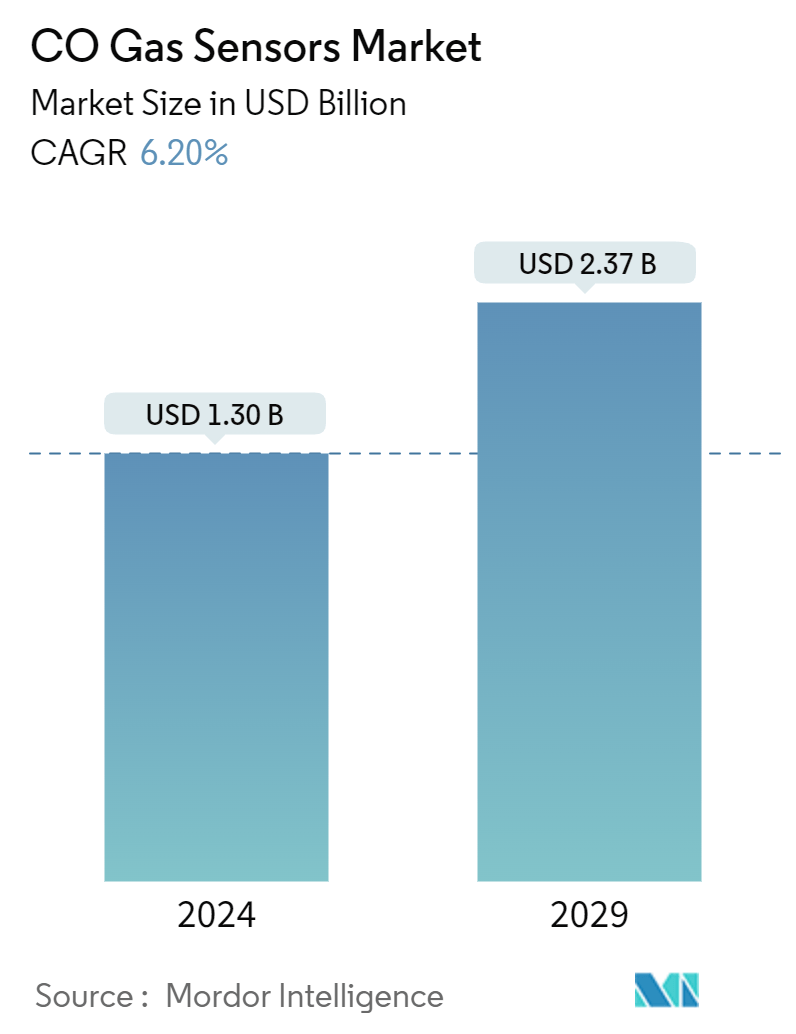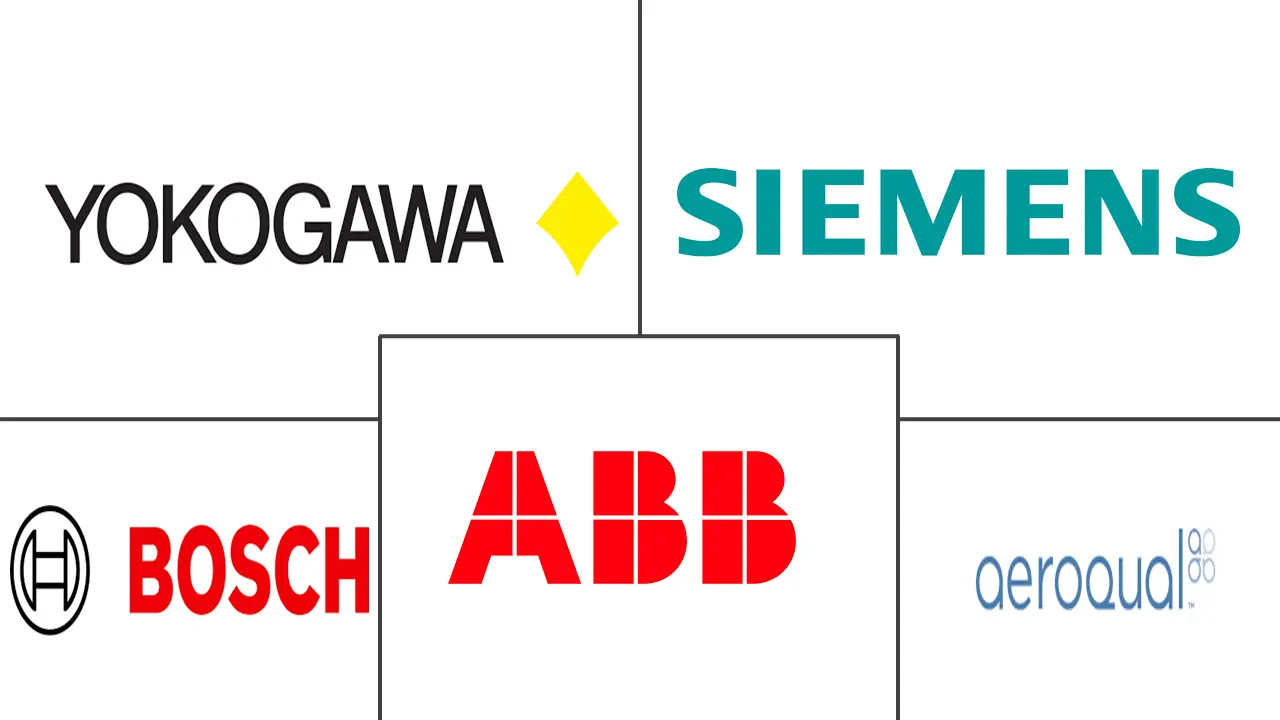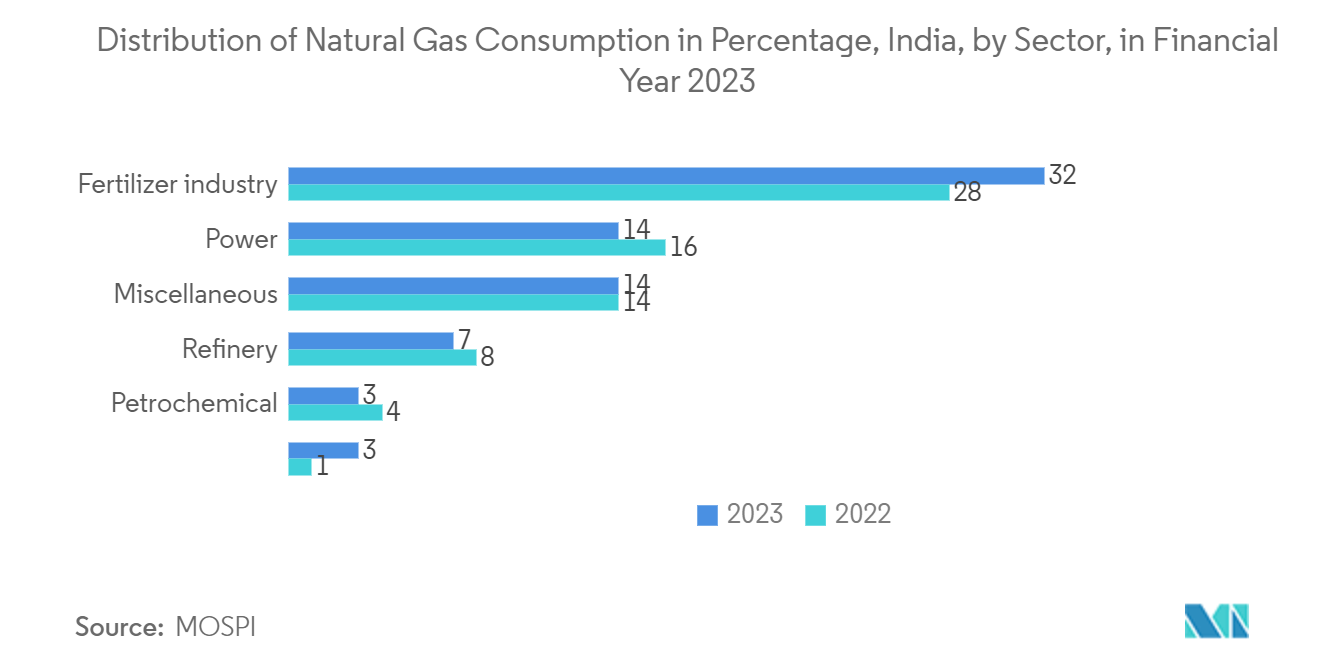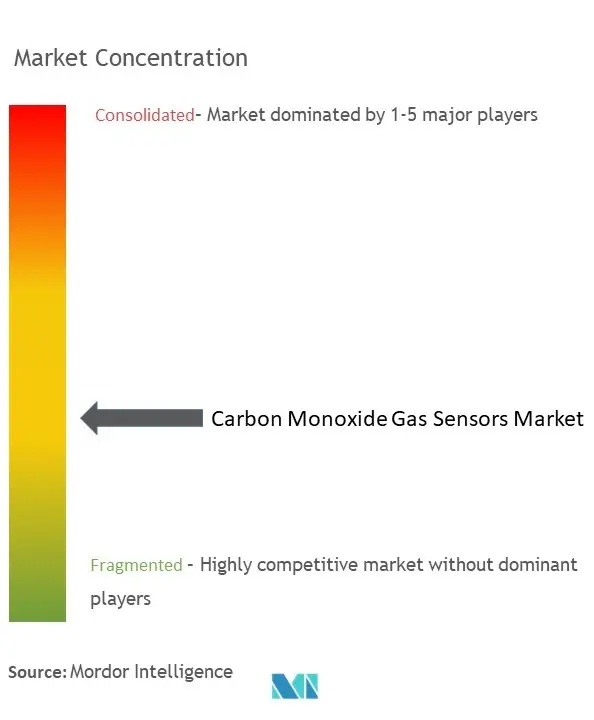Carbon Monoxide Gas Sensors Market Size

| Study Period | 2019 - 2029 |
| Market Size (2024) | USD 1.30 Billion |
| Market Size (2029) | USD 2.37 Billion |
| CAGR (2024 - 2029) | 6.20 % |
| Fastest Growing Market | Asia Pacific |
| Largest Market | North America |
Major Players
*Disclaimer: Major Players sorted in no particular order |
Carbon Monoxide Gas Sensors Market Analysis
The CO Gas Sensors Market size is estimated at USD 1.30 billion in 2024, and is expected to reach USD 2.37 billion by 2029, growing at a CAGR of 6.20% during the forecast period (2024-2029).
Industries have different applications, with some industries using CO gas for their process-related works and other sectors releasing it as a byproduct. To ensure a secure working environment and avoid any life-threatening exposure to the workers, stringent regulations are followed in the industries. These regulations have been critical in the high-paced and early adoption of CO gas alarms and detectors. Thus, this has directly impacted the increased demand for CO gas sensors in industries.
These sensors play a vital role in safeguarding human lives by providing early warnings when carbon monoxide levels rise to hazardous concentrations. These sensors enable swift evacuation and intervention by alerting people to potential dangers and preventing carbon monoxide poisoning and fatalities.
Government regulations to ensure workplace safety primarily increase the growth of the carbon monoxide gas sensors market. For instance, the United Kingdom, Germany, and France have all implemented various rules to avoid the release of dangerous gasses into the atmosphere. Chemical industrial gasses are employed at low flashpoints with lower explosive limits (LEL) and a broad flammable/combustible spectrum. On the other hand, hazards induced by such gases can be minimized by continually using these gas sensors and monitors.
Additionally, the IIoT is advancing in various regions. Customers are becoming more interested in IoT carbon monoxide gas detectors, and players in the enterprise are working on launching a product range tailored to IoT solutions. The necessity for wireless sensors owing to the requirement of constant and real-time monitoring and detection of emissions is anticipated to drive up demand for CO gas detectors in the coming years.
Further, product miniaturization has helped develop portable gas sensor devices that provide carrying flexibility. In these industries, there is a high focus on adopting automation and collecting all the data. Such a requirement has resulted in increased demand for wireless sensors that are enabled with two-way communication features.
However, the absence of regulatory requirements limits market growth as the urgency to adopt these sensors decreases. CO gas sensors have improved significantly, but there are certain technological limitations. For example, some sensors have difficulty detecting low levels of carbon monoxide, have a limited lifespan, and require frequent calibration. These technical limitations are expected to hinder the carbon monoxide gas sensor market.
Additionally, the Russia-Ukraine war is impacting the supply chain of semiconductors and electronic components, being a significant supplier of raw materials for producing semiconductors and electronic components, including sensors. The dispute has disrupted the supply chain, causing shortages and price increases for these materials, impacting carbon monoxide (CO) gas sensor manufacturers and potentially leading to higher costs for end users.
Carbon Monoxide Gas Sensors Market Trends
The Petrochemical Segment to Witness Growth
- Carbon monoxide sensors are being rapidly deployed in the LPG and LNG sectors since these industries require a check at every stage of gas storage, production, or transportation. The demand for safety and security at processing installations has also been increasing while natural gas production is growing worldwide. The growth of this segment is expected to be driven by the continued increase in gas products, and according to MOSPI, petrochemicals accounted for 37% of India's total energy consumption that year.
- With a current TWA of only 5,000 ppm, carbon dioxide is more than twice as heavy as air. Currently, 40,000 ppm or 4% by volume of IDLH is in use. Toxic exposure symptoms are headache, trouble breathing, increased heart rate, and convulsions.
- In the petrochemical industry, oil recovery and urea and methanol production require CO2 gas monitoring with a sensor that continuously detects CO2 levels and issues constant alarm commands when the gas is in toxic quantities.
- They are also used to detect gas leaks and monitor air quality. Carbon monoxide sensors can be used with other instruments, such as a thermal imager or an infrared camera, to help identify the source of the gas leak.

North America is Expected to Hold Significant Market Share
- The region is investing significantly in market growth. The rising industrial safety measures, increasing applications in the industrial sector, and an increasing number of deaths due to CO across the region further create demand for CO gas sensors.
- In addition, according to the Ontario Association of Fire Chiefs, more than 50 people die yearly from CO poisoning across Canada; as people use fuel-burning appliances more often to keep warm in winter, the deaths are mainly due to cold weather conditions. As a result, adopting carbon monoxide (CO) gas sensors is beneficial, as these appliances can unknowingly cause dangerous levels of CO gas to build up in the home. The CO gas sensors are primarily used in carbon monoxide detectors and alarms.
- According to IEA's Annual Energy Outlook 2022, petroleum and natural gas are expected to be the most-consumed power sources in the United States through 2050. In contrast, renewable energy is expected to be the fastest growing. The increasing incentives for solar and wind energy and declining technology costs support robust competition with natural gas for electricity generation. Such initiatives will drive the demand for CO gas sensors during the forecast period.
- North America will be a lucrative market during the forecast period due to huge investments by manufacturers in R&D activities concerning new environmentally friendly products.
- There are laws in many states and provinces of the region that require CO gas sensors to be installed in homes and other buildings as a precautionary measure against carbon monoxide poisoning. The demand for CO gas sensors in the region has increased significantly owing to all regulations relating to sensor devices.
- There have been a few incidents of CO poisoning recently. Nine people were sent to a hospital in Ontario, Canada, and one person died in a vehicle in Alberta. In light of such events, Health Canada is warning Canadians to be alert in their homes and elsewhere and aware of carbon monoxide's dangers. Such events will drive North America's demand for CO gas sensors.

Carbon Monoxide Gas Sensors Industry Overview
The carbon monoxide gas sensors market is semi-consolidated, has gained a competitive edge in the past three decades, and consists of several major players. In terms of market share, few of the prominent players currently dominate the market. However, with increasing innovations and safety regulations due to gas leakage incidents, the companies in the market are strategically innovating in providing these sensors, which meet the rules and policies.
April 2024: Honeywell announced that it will be the first gas detector manufacturer in the ‘Made in Saudi’ initiative, reaffirming its dedication to fostering localization and economic diversification in Saudi Arabia. It will locally assemble and calibrate three distinct gas detection solutions at its Dammam facility. Among these solutions is the Honeywell BW Max XT II, portable multi-gas detector workers use to detect gases like hydrogen sulfide and carbon monoxide in hazardous environments.
October 2023: ABB announced extending its carbon capture collaboration to support the future workforce and energy transition with Imperial College. ABB aims to equip the students with the skills needed to run industrial processes by demonstrating how the latest technology can help optimize plant performance and safely manage emergencies in real-life applications.
Carbon Monoxide Gas Sensors Market Leaders
-
Aeroqual Ltd
-
ABB Ltd
-
Siemens AG
-
Yokogawa Electric Corporation
-
Robert Bosch GmbH
*Disclaimer: Major Players sorted in no particular order

Carbon Monoxide Gas Sensors Market News
- March 2024: Teledyne Gas and Flame Detection launched the high-performance OLCT 100-XP-MS range of flammable gas detectors, incorporating cutting-edge MEMS (micro-electromechanical systems) sensor technology. By offering catalytic oxidation, IR, and MEMS sensor technologies in a single device, the OLCT100-XP-MS represents a holistic solution that revolutionizes flammable gas detection, regardless of environmental or operational constraints.
- September 2023: NASA-Built Greenhouse Gas Detector moves closer to launch. The NASA Jet Propulsion Laboratory in Southern California was the designer and builder. The nonprofit organization CarbonMapper will be supported in collecting data on greenhouse gas point source emissions with the help of this scientific instrument.
Carbon Monoxide Gas Sensors Market Report - Table of Contents
1. INTRODUCTION
- 1.1 Study Assumptions and Market Definition
- 1.2 Scope of the Study
2. RESEARCH METHODOLOGY
3. EXECUTIVE SUMMARY
4. MARKET INSIGHTS
- 4.1 Market Overview
- 4.2 Industry Value Chain Analysis
-
4.3 Industry Attractiveness - Porter's Five Forces Analysis
- 4.3.1 Threat of New Entrants
- 4.3.2 Bargaining Power of Buyers
- 4.3.3 Bargaining Power of Suppliers
- 4.3.4 Threat of Substitute Products
- 4.3.5 Intensity of Competitive Rivalry
- 4.4 Impact of Macroeconomic Trends on the Market
5. MARKET DYNAMICS
-
5.1 Market Drivers
- 5.1.1 Government Regulations to Ensure Safety in Work Places
- 5.1.2 Increasing Need for Emission Control Standards
-
5.2 Market Restraints
- 5.2.1 Lack of Awareness of Safety Gains in SME
- 5.2.2 Cost of Maintenance and Low Product Differentiation
6. MARKET SEGMENTATION
-
6.1 By Technology
- 6.1.1 Semiconductor Sensor
- 6.1.2 Electrochemical Sensor
- 6.1.3 Solid State/MOS Sensor
- 6.1.4 PID
- 6.1.5 Catalytic
- 6.1.6 Infrared
-
6.2 By Application
- 6.2.1 Medical
- 6.2.2 Petrochemical
- 6.2.3 Building Automation
- 6.2.4 Industrial
- 6.2.5 Environmental
- 6.2.6 Automotive
- 6.2.7 Other Applications
-
6.3 By Geography***
- 6.3.1 North America
- 6.3.2 Europe
- 6.3.3 Asia
- 6.3.4 Australia and New Zealand
- 6.3.5 Latin America
- 6.3.6 Middle East and Africa
7. COMPETITIVE LANDSCAPE
-
7.1 Company Profiles*
- 7.1.1 Aeroqual Ltd
- 7.1.2 ABB Ltd
- 7.1.3 Siemens AG
- 7.1.4 Yokogawa Electric Corporation
- 7.1.5 Robert Bosch GmbH
- 7.1.6 GfG Europe Ltd
- 7.1.7 Alphasense
- 7.1.8 Dynament Ltd
- 7.1.9 NGK Insulators Ltd
- 7.1.10 Trolex Ltd
- 7.1.11 Honeywell
8. INVESTMENT ANALYSIS
9. FUTURE OF THE MARKET
** Subject To AvailablityCarbon Monoxide Gas Sensors Industry Segmentation
Carbon monoxide (CO) gas sensors are used in industries and at home to detect the concentrations of CO in the air. These sensors also output the reading as an analog voltage, triggering an alarm or providing a visual indication based on other complementing features.
The carbon monoxide gas sensors market is segmented by technology (semiconductor sensor, electrochemical sensor, solid state/MOS sensor, PID, catalytic, and infrared), application (medical, petrochemical, building automation, industrial, environmental, automotive, and other applications), and geography (North America, Europe, Asia-Pacific, Latin America, and Middle East and Africa). The market sizes and forecasts are provided in terms of value (USD) for all the above segments.
| By Technology | Semiconductor Sensor |
| Electrochemical Sensor | |
| Solid State/MOS Sensor | |
| PID | |
| Catalytic | |
| Infrared | |
| By Application | Medical |
| Petrochemical | |
| Building Automation | |
| Industrial | |
| Environmental | |
| Automotive | |
| Other Applications | |
| By Geography*** | North America |
| Europe | |
| Asia | |
| Australia and New Zealand | |
| Latin America | |
| Middle East and Africa |
Carbon Monoxide Gas Sensors Market Research FAQs
How big is the CO Gas Sensors Market?
The CO Gas Sensors Market size is expected to reach USD 1.30 billion in 2024 and grow at a CAGR of 6.20% to reach USD 2.37 billion by 2029.
What is the current CO Gas Sensors Market size?
In 2024, the CO Gas Sensors Market size is expected to reach USD 1.30 billion.
Who are the key players in CO Gas Sensors Market?
Aeroqual Ltd, ABB Ltd, Siemens AG, Yokogawa Electric Corporation and Robert Bosch GmbH are the major companies operating in the CO Gas Sensors Market.
Which is the fastest growing region in CO Gas Sensors Market?
Asia Pacific is estimated to grow at the highest CAGR over the forecast period (2024-2029).
Which region has the biggest share in CO Gas Sensors Market?
In 2024, the North America accounts for the largest market share in CO Gas Sensors Market.
What years does this CO Gas Sensors Market cover, and what was the market size in 2023?
In 2023, the CO Gas Sensors Market size was estimated at USD 1.22 billion. The report covers the CO Gas Sensors Market historical market size for years: 2019, 2020, 2021, 2022 and 2023. The report also forecasts the CO Gas Sensors Market size for years: 2024, 2025, 2026, 2027, 2028 and 2029.
CO Gas Sensors Industry Report
Statistics for the 2024 CO Gas Sensors market share, size and revenue growth rate, created by Mordor Intelligence™ Industry Reports. CO Gas Sensors analysis includes a market forecast outlook 2029 and historical overview. Get a sample of this industry analysis as a free report PDF download.



